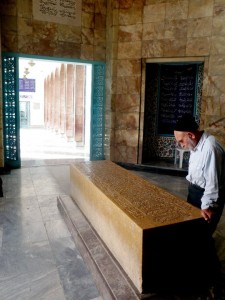The following post is written by Professor Sarah Sharp who recently participated on a Reality Tour to Iran. While there, she was inspired by the great Persian poet Saadi, wondering, how would Saadi encourage the participants to embrace their travel experiences?
The 13th century Persian poet Saadi traveled widely, visiting Syria and China, as well as many sites in Europe, and throughout Persia, of course. He liked to give advice and he encouraged “good thoughts, good talks, and good deeds,” according to our Iranian tour guide, Bahman.
One day, we stopped in at a madrasa to see Shi’ite Islamic classes in session, housed in a Safavid era building. Mullahs were speaking outside in the central garden spaces. I hoped to photograph a small group and was quickly waved off by one of the individuals. Iran’s supreme leader supervises all of the country’s system of madrasas through his appointees. To truly understand the theological training that occurs in these seminaries, and even to see further by visiting Qom, Iran’s theological center, a city with hundreds of madrasas for men and women, would take a much longer journey. But we can harness twin efforts from what we do see. For one, we can ask questions about religion and its full-bodied dimensions in Iran’s society. For another, we can imagine that Saadi is walking a bit ahead of us, encouraging to be generous in all meetings and settings.
Touring with Saadi would refresh us in every way. While at his tomb earlier this evening, I saw a mother feeding ice cream to her child. I caught her eye, smiled to her, and simply said, “Salaam.” She followed me, offered to have me hold her daughter and then she took our picture. We encountered many groups of young and older families, youths, strolling through this park that surrounded Saadi’s tomb. Not only were the strollers curious about us, but they genuinely wanted to communicate with us. They said, “Hello,”and gave us other greetings. Saadi would have urged us, like the small child, to extend ourselves with a warm hospitality somehow, whether we could speak the same language or not.
We have returned a few times to a gallery to see a wide variety of Persian carpets, collected from several regions across Iran. Not only are they rich in color and design, but many of them have a single motif that repeats across regional specialty. The cypress tree. Visiting Iran’s 4000-year old cypress tree a few days ago gave me a chance to record bird sounds coming from the tree, but also to photograph families doing what we were doing — getting a close look at this natural wonder. I didn’t realize that I wasn’t done with that part of Iran’s past until I saw the cypress tree woven into many of the carpets. What would Saadi make of this connection? Maybe he would encourage us to see the beauty of both past and present.
Saadi’s poetry is a grand gift from Persia’s past, as well as Iran’s present. As a fellow traveler, I can hope, a bit, to walk just bit behind Saadi and appreciate his point of view, “good thoughts, good talks, good deeds.
Thanks Sarah for sharing your experiences with us!
- If you are in the Bay area, please join recent Reality Tour participant Marc Sapir for a report back from his travels in Iran. The event is December 8 at 7pm at the Berkeley Fellowship of Unitarian Universalists Fellowship Hall, Cedar and Bonita, Berkeley, CA. For questions about the event, please contact Marc at marcsapir@gmail.com.
- Learn more about traveling on a Reality Tour to Iran!

